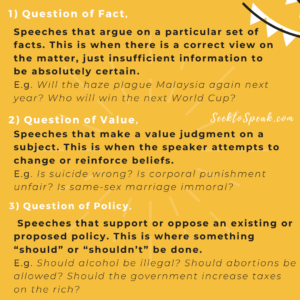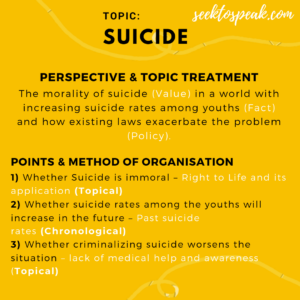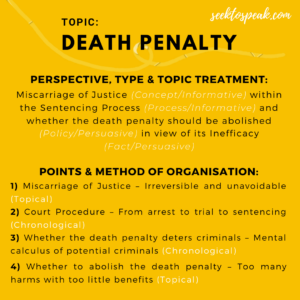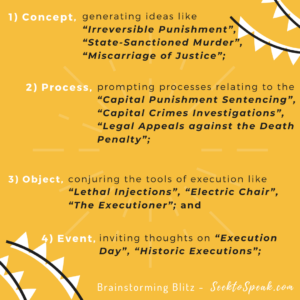Persuasive Speeches & Everything In-Between
According to Stephen E. Lucas in his book, “The Art of Public Speaking”, there are three (3) types of persuasive speeches – those that deal with a Question of Fact, a Question of Value or a Question of Policy. Regardless of which side a speaker is on, the subject matter of persuasive speeches would typically fall under either one of the following categories:
1) Question of Fact: Speeches that argue on a particular set of facts. This is when there is a correct view on the matter, just insufficient information to be absolutely certain. For example, Will the haze plague Malaysia again next year? Who will win the next World Cup? Does affirmative action work?
2) Question of Value: Speeches that make a value judgment on a subject. This is when the speaker attempts to change or reinforce beliefs. For example, is suicide wrong? Is corporal punishment unfair? Is same-sex marriage immoral?
3) Question of Policy: Speeches that support or oppose an existing or proposed policy. This is where something “should” or “shouldn’t” be done. For example, Should alcohol be illegal? Should abortions be allowed? Should the government increase taxes on the rich?

Application
These speeches are categorised in that manner in order to figure out how best to organise information and achieve a speaker’s aims. For example, in a speech on a Question of Value, the speaker would first need to establish the standard of value judgment and then secondly, apply such standards to the subject matter.
Using this method and on the speech, “Suicide”, my speech structure would look like this:
While I agree with Stephen that persuasive speeches largely fall under these categories and that such methods of identification and organisation would be helpful, I disagree with the strict link he imposes between categories and information structure. I believe that the best persuasive speeches include an evaluation, to a certain extent, of all three questions of fact, value, and policy. This way, speeches would be fact-based, principally sound and realistic.
Brainstorming Blitz
Much like the Brainstorming Blitz method I had recommended in the first installment of this series, you need to force your mind into seeing the topic as a question of fact, value AND policy. This will allow you to analyze the principles and issues surrounding the subject matter (value judgment), research data collected on the topic (factual backing) and discuss existing or proposed solutions (policy watch). Using the Brainstorming Blitz method and on the same topic of “Suicide”, my speech structure would then be:

The above speech analyzes the topic from various perspectives, making it harder for the audience to argue with the speaker and increases the likelihood of them agreeing.
Informative/Persuasive
Most public speaking books will tell you that there are two (2) types of speeches, informative and persuasive. Informative speeches are geared towards imparting knowledge onto the audience in a neutral, non-bias way. In contrast, persuasive speeches intend to change mindsets and are biased to one side. Hence, this Topic Treatment series is divided into two (2) parts, informative and persuasive speeches.
Nevertheless, I feel like the line between these speeches is very thin and a persuasive speech can be equally (if not more) informative and an informative speech can be persuasive without even intending to. Hence, do not make a distinction between the Brainstorming Blitz used for informative and persuasive speeches. Do not first decide what kind of speech to present and limit the Brainstorming Blitz exercise to that type of speech.
Double Brainstorming Blitz
What do I mean by this? Once a topic is released, immediately apply the Brainstorming Blitz method on the topic as if the speech is both informative and persuasive. This will help generate a plethora of ideas that will then allow you to pick the best content. For example, on the topic, “Death Penalty”, I will not decide the type of speech it will be and instead, immediately treat the topic as a;
AND

After the double Brainstorming Blitz exercise, I then pick and choose the ideas that are most interesting and related in such a way that the speech flows well and is both informative and persuasive in nature. Hence, my speech structure on the topic, “Death Penalty”, as a result of the above exercise would be;


